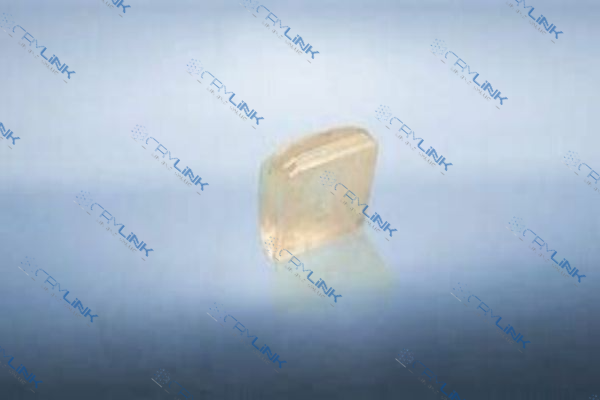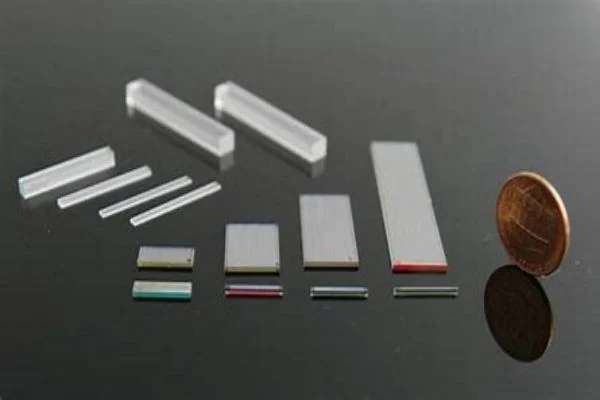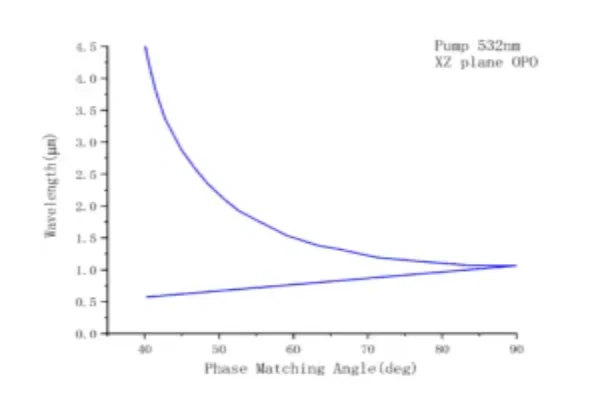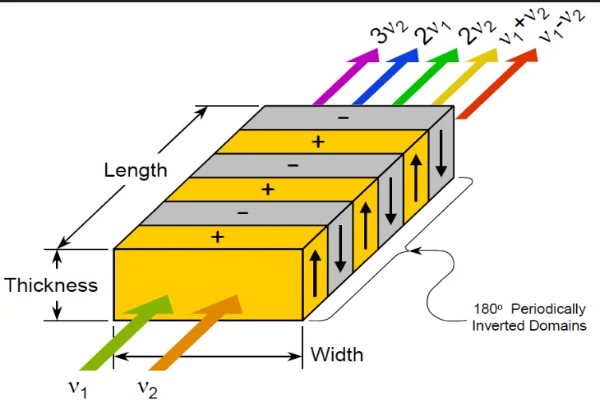Introduction
Nonlinear crystals play a critical role in the field of photonics, particularly in the design and operation of Optical Parametric Oscillators (OPOs). The unique properties of these crystals have revolutionized our ability to generate and manipulate laser light, leading to groundbreaking applications in diverse sectors.
Understanding Nonlinear Crystals
Nonlinear crystals, central to the operational mechanism of Optical Parametric Oscillators (OPOs), harness unique physical properties to transform light frequencies. The two most prominent types, Periodically Poled Lithium Niobate (PPLN) and Potassium Titanyl Phosphate (KTP), offer specific advantages that make them ideal for OPO applications.
Periodically Poled Lithium Niobate (PPLN): A Superior Nonlinear Crystal
PPLN is an influential player in the realm of nonlinear crystals due to its exceptional attributes:
- High Nonlinear Optical Coefficient: PPLN’s nonlinear optical coefficient is one of the highest among all optical materials, leading to efficient frequency conversion processes and more robust OPO performance.
- Broad Transparency Range: The broad transparency range of PPLN, from the visible to the mid-infrared region, empowers OPOs to produce a wide array of wavelengths, enhancing their tunability and application potential.
- Robust Thermal Conductivity: The high thermal conductivity of PPLN enables effective heat dissipation, essential in high-power operations to prevent detrimental thermal effects.
- Quasi-Phase Matching through Periodic Poling: PPLN employs a novel method called quasi-phase matching, facilitated by its periodic poling, to optimize the efficiency of nonlinear interactions. This approach overcomes phase-mismatch limitations intrinsic to conventional crystals, amplifying the light conversion efficiency significantly.

Potassium Titanyl Phosphate (KTP): An Exceptional Choice for High-Power Applications
Equally impressive is KTP, a nonlinear crystal offering a different set of strengths:
- Strong Nonlinearity: The pronounced nonlinearity of KTP facilitates effective frequency conversion processes, thereby enhancing the overall efficiency of the OPO.
- Wide Transparency Window: Like PPLN, KTP’s wide transparency window enables generation of a broad range of frequencies, extending from the visible to the near-infrared region.
- High Damage Threshold: KTP’s high damage threshold indicates its resilience under high-power density conditions, making it particularly suitable for high-power OPO applications.
- Efficient Second Harmonic Generation: KTP is renowned for its efficient second harmonic generation capacity, a property that facilitates frequency doubling of standard lasers such as Nd:YAG. This capability broadens the operational spectrum of OPOs, further enriching their application scope.

Exploring the Use of Nonlinear Crystals in Optical Parametric Oscillators to Generate Tunable Laser Sources
The use of nonlinear crystals in Optical Parametric Oscillators (OPOs) is pivotal to generate tunable laser sources. The mechanism primarily relies on the nonlinear optical process known as parametric down-conversion that these crystals facilitate.
Understanding the Process of Parametric Down-Conversion
Parametric down-conversion involves the conversion of a photon with higher energy, known as the pump photon, into two photons of lower energy, termed as signal and idler photons. This process occurs within the nonlinear crystal, leading to the generation of light at different frequencies.
Tunability of Laser Sources with OPOs
OPOs exploit this parametric down-conversion process to produce tunable laser sources. The frequency of the output laser light (signal and idler) can be continuously varied by changing the phase-matching condition in the nonlinear crystal. This is generally achieved by altering the temperature of the crystal or its orientation. Thus, by fine-tuning the phase-matching conditions within the OPO, a wide range of laser frequencies can be accessed.
Influence of Nonlinear Crystals on Tunability
The choice of nonlinear crystal in the OPO strongly influences its tunability. For instance, crystals like Periodically Poled Lithium Niobate (PPLN) and Potassium Titanyl Phosphate (KTP) offer broad phase-matching bandwidths. This, in turn, allows for the generation of a wide range of signal and idler wavelengths, leading to highly tunable laser sources.

Optimizing Nonlinear Crystals for Enhanced Tunability
Further enhancements in tunability can be achieved by optimizing the design and properties of the nonlinear crystals. For example, periodically poled crystals exhibit quasi-phase matching, a technique that allows for more efficient nonlinear interactions and provides additional freedom in selecting the output wavelengths. Through these advances, OPOs have been able to produce laser light that spans the entire visible to mid-infrared spectral range.
In conclusion, the use of nonlinear crystals in OPOs has been a game-changer in generating tunable laser sources. These crystals, due to their unique properties, have made it possible to generate light across a broad range of frequencies, enabling a multitude of applications in areas such as spectroscopy, biomedical imaging, and quantum communication.
PPLN crystals-crylink3
Advantages of Specific Nonlinear Crystals in OPO Technology
In Optical Parametric Oscillator (OPO) technology, the choice of nonlinear crystal is crucial as it directly impacts the efficiency and performance of the system. Two nonlinear crystals, in particular, have proven advantageous – Periodically Poled Lithium Niobate (PPLN) and Potassium Titanyl Phosphate (KTP).
Advantages of Periodically Poled Lithium Niobate (PPLN) in OPO Technology
PPLN is widely recognized for its exceptional characteristics that offer several advantages in OPO technology:
- High Nonlinear Coefficient: PPLN has one of the highest nonlinear coefficients among practical nonlinear optical materials. This property results in higher conversion efficiency, making PPLN an ideal choice for OPOs.
- Broad Transparency Range: PPLN exhibits a broad transparency range, extending from the visible to the mid-infrared region. This allows PPLN-based OPOs to generate a wide range of tunable wavelengths.
- Quasi-Phase Matching: Periodic poling allows PPLN to achieve quasi-phase matching, a technique used to maximize the efficiency of the nonlinear interaction. This makes PPLN particularly effective in frequency conversion applications.
Advantages of Potassium Titanyl Phosphate (KTP) in OPO Technology
KTP is another widely used nonlinear crystal in OPOs, and its use comes with several advantages:
- Strong Nonlinearity: Like PPLN, KTP has a strong nonlinearity, which allows for efficient frequency conversion processes.
- High Damage Threshold: KTP has a high damage threshold, which makes it resilient under high power density conditions. This makes KTP-based OPOs suitable for high-power applications.
- Wide Transparency Range: KTP has a wide transparency range from the visible to the near-infrared region. This allows KTP-based OPOs to generate a wide range of tunable output.
- Temperature Bandwidth: KTP has a relatively large temperature acceptance bandwidth, which allows for stable operation of the OPO over a range of temperatures.

Applications of Optical Parametric Oscillators in Various Fields
Optical Parametric Oscillators (OPOs), with their versatile tunability and broad wavelength coverage, find significant applications in several fields. Among these, spectroscopy, imaging, and quantum optics are areas where OPOs have made significant contributions.

Spectroscopy
In spectroscopy, OPOs offer several advantages over traditional laser sources:
- Broad Tunability: OPOs can cover a wide range of wavelengths, from the ultraviolet to the mid-infrared, making them ideal for studying a vast array of molecules and materials.
- High Spectral Brightness: The high output power and narrow linewidth of OPOs result in high spectral brightness, crucial for high-resolution spectroscopy.
- Pulse Shaping: The temporal characteristics of OPOs can be tailored to suit specific requirements, which is particularly useful in time-resolved spectroscopy.
Imaging
In the field of imaging, OPOs find use in various ways:
- Multi-wavelength Imaging: The broad tunability of OPOs allows for multi-wavelength imaging, beneficial in applications like multispectral imaging and hyperspectral imaging.
- Medical Imaging: In biomedical fields, OPOs facilitate techniques like Optical Coherence Tomography (OCT) and photoacoustic imaging, providing high-resolution images of biological tissues.
Quantum Optics
Quantum optics is another field where OPOs have made significant contributions:
- Generation of Quantum States: OPOs are instrumental in generating non-classical states of light, such as squeezed states and entangled states, which are vital for quantum communication and quantum computation.
- Quantum Metrology: The unique properties of light generated by OPOs are beneficial in quantum metrology, enabling measurements with precision beyond classical limits.
Conclusion
In the world of photonics, nonlinear crystals are transforming Optical Parametric Oscillator (OPO) technology, revolutionizing the way we generate and manipulate light. By enabling tunable laser sources, they have catalyzed advancements in a myriad of applications, from precision-driven spectroscopy to high-resolution imaging and cutting-edge quantum optics. Their influence extends beyond just frequency conversion. By virtue of their unique attributes, nonlinear crystals like Periodically Poled Lithium Niobate (PPLN) and Potassium Titanyl Phosphate (KTP) have emerged as key enablers, unlocking broader spectral ranges and greater operational efficiency. As we continue to explore and optimize these crystals, we stand on the brink of unprecedented advancements in photonics. As technology marches forward, these applications are set to expand exponentially, ushering in a new epoch of discovery and innovation in light-based technologies. The era of nonlinear crystals is not just upon us; it is helping us shape a future where light does more than just illuminate – it empowers.
FAQs
- 1. What are the primary types of nonlinear crystals used in OPOs?
- The primary types of nonlinear crystals used in OPOs are Periodically Poled Lithium Niobate (PPLN) and Potassium Titanyl Phosphate (KTP).
- 2. What is the role of nonlinear crystals in OPOs?
- Nonlinear crystals in OPOs facilitate the conversion of higher energy pump light into lower energy signal and idler light, a nonlinear optical process known as parametric down-conversion.
- 3. How do OPOs enable tunable laser sources?
- OPOs utilize the unique properties of nonlinear crystals to convert one frequency of light into two other frequencies, creating a wide range of frequencies and thereby enabling tunable laser sources.
- 4. What are some applications of OPOs?
- OPOs have a wide range of applications including spectroscopy, imaging, and quantum optics.
- 5. What makes PPLN and KTP particularly suited for OPO technology?
- PPLN is notable for its high nonlinear optical coefficient, broad transparency range, and robust thermal conductivity. KTP has strong nonlinearity, a wide transparency window, and a high damage threshold, making it suited to high power applications.







